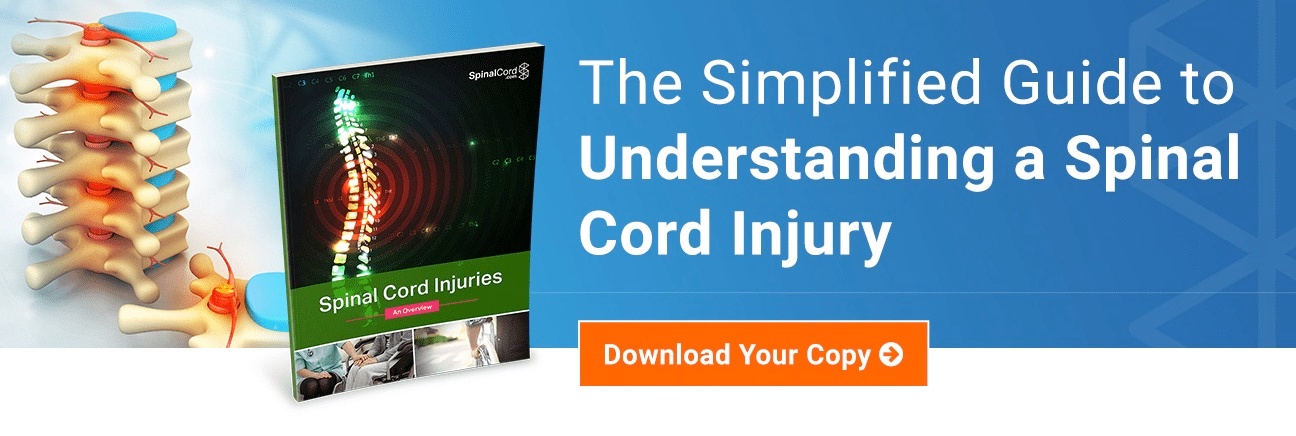Recovering from a C6 Spinal Cord Injury: Healing and Exercises
Maintaining an exercise routine after a spinal cord injury (SCI) is especially vital to staying healthy and active. Due to these injuries, many SCI survivors may find themselves living a sedentary lifestyle, which can lead to additional health conditions.
Exercise and Staying Healthy after an SCI

However, studies show that staying physically active after a spinal cord injury can help to improve a patient’s quality of life. Furthermore, it also can reduce the occurrence of many of these secondary conditions, which include:
- Cardiovascular disease, circulation issues, and other related complications;
- Diabetes;
- Muscle spasms and atrophy;
- Loss of range of motion;
- Osteoporosis;
- Depression;
- Pressure ulcers;
- Bowel irregularity; and
- Urinary tract infections (UTIs).
But, if you’ve suffered a severe damage to the cervical spinal cord, such as a C6 spinal cord injury, is it even possible to stay physically active? The answer to this depends on the severity and location of your injury, as well as your personal determination to follow an exercise regimen. There are exercises designed for people living with a spinal cord injury that you may be able to do safely.
C6 Level Spinal Cord Injuries
The cervical spinal cord is located in the topmost region of the spinal column and corresponds with the neck. The seven vertebra within this region, are known as the C1-C7 sections of the spinal cord(from the top to the bottom). The C1 vertebra is the highest part of the cervical spinal column, while the C7 vertebra is the lowest. The higher the injury on the cervical spine, the more extensive the damage and the higher the risk of the SCI being fatal.
A C6 spinal cord injury is one that affects the lower end of the cord near the base of the neck. Injuries to this area of the spinal cord can result in loss of sensation or function of everything in the body from the top of the ribcage on down, including all four extremities, or what is known as quadriplegia.
However, an injury in this area doesn’t necessarily mean that all hope is lost. Some quadriplegics have been able to regain some function once the swelling at the sites of their injuries reduced or if they had surgery to remove something that was pressing against or otherwise impeding their spinal cords. As such, they were then able to continue to engage in physical activity. Some patients even can drive a modified car through the use of hand controls.
Amanda Perla is a great example of this kind of situation. Perla, a spinal cord injury survivor who is a C6 incomplete quadriplegic, has found a way to stay physically active after being severely injured in a car accident using activity-based therapy (ABT). Perla says she exercises regularly, has a part-time job, and can drive again. She also participates in several adaptive sports, including surfing, handcycling, and water skiing.
So, what is ABT? And, how does it work?
What Is Activity-Based Therapy? How Does It Help with Spinal Injuries?
Unlike traditional physical therapy, activity-based therapy (also known as activity-based restorative therapy, or ABRT) is an aggressive exercise-based therapy that aims to improve sensory perception and muscle function in a patient’s body below their level of injury. When you engage in this type of therapy, you are physically taken through a series of everyday movements — all while your entire body is out of your wheelchair — that involves strength training and load-bearing exercises.
These spinal cord injury exercises involve repeated movements, which aim to help you to establish functional movement patterns that:
- Promote neuroplasticity;
- Improve range of motion (ROM) and flexibility;
- Develop core and trunk strength;
- Create load-bearing capabilities;
- Improve bowel regularity; and
- Promote bone health.
Studies show that engaging in weight-bearing activities “have not only been shown to slow the loss of bone during the acute stage of SCI and decrease extensor muscle spasms, but also to provide a wide range of benefits imperative to overall health.”
Functional Electric Stimulation Training and C6 Spinal Injuries
Functional electric stimulation (FES) studies using a computer and electrodes to stimulate paralyzed muscles through small bursts of energy have shown promising results. Through this stimulation, patients have demonstrated improvements in their respiration, bladder and bowel control, and hand movements. Some patients have even been able to move their legs for the first time in years.
Although the FES leg cycling exercise on its own may be insufficient to promote aerobic fitness, studies have shown that “combined arm + leg FES training at submaximal exercise intensities may lead to greater gains of aerobic fitness than would arm exercise alone.”
If you’ve suffered a traumatic injury to your C6 cervical spinal cord, the best thing that you can do is seek treatment as early as possible. Once you’re able to do so, begin engaging in physical therapy, activity-based therapy, and exercises to keep your body moving. Although this will be challenging, it will only serve to your benefit.
Stay Updated on Advancements On Traumatic Brain &
Spinal Cord Injuries
About the Author





